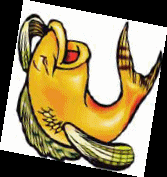SEJournal Online is the digital news magazine of the Society of Environmental Journalists. Learn more about SEJournal Online, including submission, subscription and advertising information.

Bits and Bytes
By DAVID POULSON
Our Great Lakes Echo environmental news service once ran an image of a giant Asian carp plucking an unsuspecting toddler from a Lake Michigan beach.
Another time we featured Sarah Palin shooting a carp with an automatic weapon.
We also showcased a giant carp floating above Chicago like the Goodyear blimp. And we revealed the presence of two of the fish in the chambers of the U.S. Supreme Court.
These reader-manipulated images grew out of our desire to build the greater engagement that all online news sites crave.
The verdict: Humor works.
Engaging readers is what journalism is all about. You can't use the wisdom of the crowds if the crowd isn't there. So when you build it and they don't come, what do you do?
Try poking your readers with a sharp stick and challenging them to interact.
Some may wonder: Is this journalism? At a minimum, features like carp bombs serve the same function as crossword puzzles and comic strips. They bring people into your news community.
But they are more than marketing. They give readers motivation to become aware of the issues you explore in a more serious vein. And if they're not — we link to the serious stories.
But it's a bit like the Daily Show — you need to bring to it an awareness of the news to appreciate Jon Stewart's jokes.
Otherwise you'll never understand why those carp are peering over the shoulders of the Supreme Court justices.
Be warned that reader engagement is not an exact science. Sometimes nothing happens when we throw community engagement efforts against the Echo wall. We've asked readers to submit links to stories elsewhere to help with our aggregation efforts. Rarely do we get one.
And when something works, we're not sure why.
Don't get discouraged when your best ideas flop. You'll be surprised by something else that works. More surprising — and puzzling — is when a failed idea works the second time.
Here are some ideas to spur interaction with environmental news that we use at Great Lakes Echo:
Photo fun
 |
|
CARPet bombing.
Photo  By Outside Perspectives / Gordon Via Flickr. By Outside Perspectives / Gordon Via Flickr. |
Asian carp are hardly sharp sticks. But we used them to stir up engagement. Armed with a voracious appetite, these critters are knocking on the door of the Great Lakes with the potential to devastate the ecosystem that Echo covers. All that's keeping them out of Lake Michigan is an electric barrier at Chicago. And they may have breached that.
After weeks of carp crisis coverage and reports on posturing politicians, we invited readers to submit to our Flickr account images of carp inserted into unusual scenes. We even provided carp images for raw materials.
When the entries rolled in, we dropped one "carp bomb" a week onto Echo's front page. But they also escaped into other media. One newspaper columnist ran our carp bombs in two of his columns.
Another gave us a picture of her downtown and asked us to insert a carp image into it. We ran it on Echo and she ran it in her paper with a story about the threat. We were happy to oblige. We were happier to gain the exposure. To extend the feature's run, we compiled a dozen carp bombs into a gallery linked off our homepage.
So while carp are terrible for our ecosystem, they've been good for us. Chances are your community has the equivalent of our carp — another invasive species or some other ecological terror to poke fun at. Everyone likes to tell a joke. Give them the tools and the encouragement to do so. To ease the technical barrier, offer to do the photoshop work if readers provide the images and the cutlines. Encourage them to share their efforts.
Play on your community's insecurities You know those annoying national media stories that highlight the top 10 "Best of Something" lists? Best bike trails. Greenest roofs. Most energy efficient buildings. How often does your community get mentioned in those?
So play up that omission. Challenge readers to set the record straight with local nominations.
When editors of Outside Magazine listed only one park in any of the eight Great Lakes states as among their favorites, we asked readers to tell us which ones from our region should have been listed.
Write a quiz
People complain about those Facebook quizzes that promise to determine such things as which television character is most similar to their personality. Yet they still take them.
These quizzes give you two shots at engagement. First, ask readers for help building one. Then ask them to take it.
Our first Echo quiz asked, "Which Great Lake are you?" Readers noted that the personality of Lake Superior was cool and inaccessible and, well, superior. And if your favorite beverage was Labatt Blue, your personality may be better suited to Lake Ontario. That was fun, but it didn't scream take me!
So we built another quiz around the question, "Which Great Lakes invasive species is your former significant other?" Readers sent some telling observations of an ex who left their home a mess, spread disease and had the bug eyes of a round goby (that's a fish). Some noted that the purple loosestrife plant is beautiful but expensive to remove, that house sparrows kill other birds and their young and take over their nests and that spotted knapweed is a loner with a toxic personality.
My favorite comment during this quiz-building phase: "My ex is definitely an Asian carp. He is huge, gross-looking and he frequently pops up when I least expect him to. I wish there was an electric fence to keep him away from Michigan. "
Make a map
Marrying data to geography is a quick addition to a news story and often can stand with little additional text. It is particularly helpful on the environmental beat when the sense of place is so critical to the story. Check out the tutorials at google maps.
You can also invite readers to contribute suggestions for map points.
One of our most trafficked stories is about Great Lakes inspired music and bands. An accompanying map pinpoints the Great Lakes connection. The points link to information about the band or song. Readers quickly made contributions. Each week we feature Monday Mashup, a map relevant to our region that we've created or found. Our hope was that readers would also contribute maps, easing the reporting burden. They haven't and I'm puzzled. Maybe we just haven't found the map nerd crowd yet. I still have hopes of engaging them. Maps are a great way to tell an environmental story.
Your physical community likely has a planning agency with mapmakers whose work may not get much attention. Rather then burying these efforts on their hard drives, they may be glad for a public platform. Invite them to contribute. Chances are if it's an issue important enough for bureaucrats to map, you should be reporting it in some manner.
Cover the environment from space
Unusual ways of reporting news engage new readers. When we animated a month's worth of still satellite images for a story about spring runoff on Lake Erie, our daily hits more than doubled.
We tapped into a community of satellite nerds. To them, our use of images taken from space was at least as interesting as what they showed. One sharp-eyed reader even noticed that we had deleted images from certain days. We had to explain those were days with heavy cloud cover, but that was an opportunity for us to demonstrate our responsiveness to engagement.
People revisited that story for months. With any luck, some stayed for the other content.
And we hope to revisit that story later this summer with satellite imagery showing algae blooms fed by the spring runoff shown in the earlier report. NASA's Earth Observatory is a good place to poke around for images, but local universities may be snagging images of your region and help you find appropriate ones.
Insert a poll
Using a third-party polling service like Polldaddy gives you a low-effort interactive feature that can run with a story, multiple stories or as a standing feature. It is a cheap way for readers to weigh in, although we find many comments are gripes about the unscientific nature of Internet polls. We never say the results support the facts of a news story. But we appreciate the engagement.
Ask for help
Reporters have used our staff blog, Catch of the Day, to seek sources, information and story angles. Later this summer we hope to take that concept a step further with another group's documentary while it's under production. Each week we will run excerpts of the footage the producers have shot. It won't be a story, but rather the disjointed building blocks of what will become a story. Our hope is that readers will suggest other people to interview or new angles to pursue. It may build interest in the final product and perhaps reach people who will not otherwise see it.
You could do this with any meaty issue that you commit to over time. And it wouldn't have to be a video. Put up an incomplete story and ask readers to tell you where to fill in the blanks.
Track your impact
Be aware that community engagement flares up in unexpected places and not necessarily where you are hoping — your own site.
Unknown to us, a mountain biking group once fed our RSS feed of recreation stories into its own forum. When a story broke about the threatened closure of a park popular among the biking crowd, the forum erupted with comments, links and stories.
A community of angry mountain bikers grew up around the threat. It's exactly the kind of thing you want to happen — except on your turf.
We post links to our stories on a statewide listserv primarily used by environmental activists. Sometimes discussion of those stories erupts there instead of on our site.
That's just a reality of online news. You may initiate it, but the community decides where it will happen. It's frustrating when your efforts produce community elsewhere.
Yet it's important activity to track as you justify your impact to funders.
Great Lakes Echo Editor David Poulson is the associate director of Michigan State University's Knight Center for Environmental Journalism. A version of this article was first written for J-Lab: The Institute for Interactive Journalism and appears on the Knight Citizen News Network.
* From the quarterly newsletter SEJournal, Fall 2010 issue.












 Advertisement
Advertisement 



